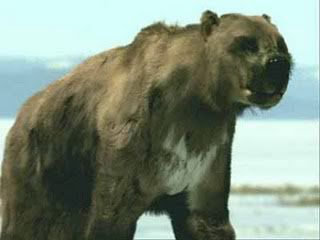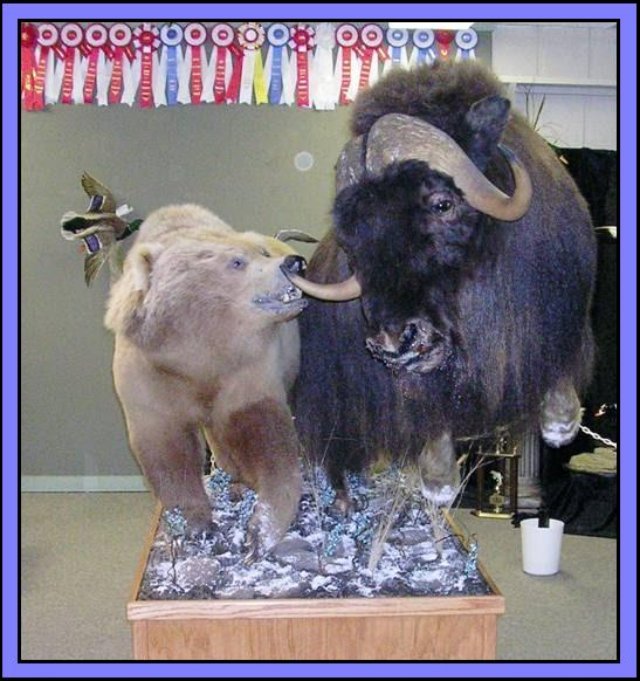Post by grrraaahhh on Nov 3, 2010 6:06:25 GMT -9
Multiple Hunting Strategy
In the Thelon Game Sanctuary, grizzlies and muskox coexist, but the relationship is not always copasetic. Near the Thelon River, bears may use thick willow stands along the waterway to ambush muskox feeding on sedge in nearby clearings. Willows also attract muskox, as it is a preferred food of this beast. Gunn and Miller (1982) report finding a bear on a freshly killed, bull O. moschatus. They were able to scare the adult bear off and examine its kill and concluded that the bear had dispatched the big ungulate by first grasping its nose (crushing the nasal turbine bones and tearing off the nose in the process) and then inflicting a crippling bite to its skull. By grasping the nose, the bear may have prevented the muskox from bringing its horns to bear and also may have been more effective at throwing the animal to the ground.
In another study carried out in the northeastern Arctic slopes of Alaska, 92 grizzly-muskox interactions were observed (Reynolds et al. 2002). Fifty percent of these were known kills, 40 % were possible kills or scavenging events, and 10 % were incidents where a grizzly was seen chasing muskox. It was estimated that 16-39 % of muskox mortality was the result of bear predation. During the study period (1982-2001) the number of muskox killed by grizzly bears was zero to two deaths per year before 1993, one to four musk ox per year from 1994-1997 and five to ten deaths per year from 1998-2001. This increase in kill numbers was a function of an increase in the size of musk ox herds. An increase in kills may also be indicative of the bears learning how to better attack and take down these big, formidable animals. While solitary adult bears were most often seen attacking muskox (69 occasions), pairs or trios of adult bears were seen chasing, killing or eating these animals (three episodes). Sows with cubs or yearlings were seen interacting with muskox on three occasions.
Surplus Killing
Grizzly bears sometimes engage in surplus killing of muskox. In the study carried out by Reynolds et al. (2002) there were ten episodes where one to three bears killed from two to four adult muskox. On several occasions even more muskox were dispatched during a single hunting bout. For example, in one case five individuals (two adult females, a yearling and unsexed adult musk ox) were incapacitated by a single bear. In another case, a grizzly killed four calves and in another incident the victims were one adult female, one two-year old male and one yearling. In most cases, solitary bears were involved in these killing sprees, but in one case three grizzlies instigated the melee.
Clarkson et al. (1993) reported a fascinating case of surplus killing of muskox calves by a heterosexual pair of adult grizzlies. Within a distance of about two km, the two bears took down five young musk ox. By doing a little forensic work, the researchers were able to put together a likely picture of what had happened. Rather than form a defensive circle to try and parry the bear attacks, this herd of musk ox tried to out run the grizzlies. The researchers postulated that the calves trailed behind the adults and, therefore, were more vulnerable. The two bears chased the herd, which consisted of 40 to 50 muskox (with a minimum of eight calves). They killed the first calf and ate 90 % of the carcass. They then chased the herd down again and about 1.5-2.0 km from the first kill dispatched a second young musk ox. They ate 60 % of this second calve and began the hunt again. They killed the third calf about 300 m from the second. The third calf was about 30 % consumed by the bears and a wolverine (Gulo gulo) that was feeding on the carcass when the researchers arrived on the scene. The fourth calve was killed 400 m from the third. A golden eagle had just begun to feed on calf four when the researchers arrived. The final calf was killed about 200 m from the fourth – this last young muskox was not eaten either.
gobiestogrizzlies.blogspot.com/2008/07/muskox-on-menu-grizzly-predation-on.html
Great (above) blogger link.
In the Thelon Game Sanctuary, grizzlies and muskox coexist, but the relationship is not always copasetic. Near the Thelon River, bears may use thick willow stands along the waterway to ambush muskox feeding on sedge in nearby clearings. Willows also attract muskox, as it is a preferred food of this beast. Gunn and Miller (1982) report finding a bear on a freshly killed, bull O. moschatus. They were able to scare the adult bear off and examine its kill and concluded that the bear had dispatched the big ungulate by first grasping its nose (crushing the nasal turbine bones and tearing off the nose in the process) and then inflicting a crippling bite to its skull. By grasping the nose, the bear may have prevented the muskox from bringing its horns to bear and also may have been more effective at throwing the animal to the ground.
In another study carried out in the northeastern Arctic slopes of Alaska, 92 grizzly-muskox interactions were observed (Reynolds et al. 2002). Fifty percent of these were known kills, 40 % were possible kills or scavenging events, and 10 % were incidents where a grizzly was seen chasing muskox. It was estimated that 16-39 % of muskox mortality was the result of bear predation. During the study period (1982-2001) the number of muskox killed by grizzly bears was zero to two deaths per year before 1993, one to four musk ox per year from 1994-1997 and five to ten deaths per year from 1998-2001. This increase in kill numbers was a function of an increase in the size of musk ox herds. An increase in kills may also be indicative of the bears learning how to better attack and take down these big, formidable animals. While solitary adult bears were most often seen attacking muskox (69 occasions), pairs or trios of adult bears were seen chasing, killing or eating these animals (three episodes). Sows with cubs or yearlings were seen interacting with muskox on three occasions.
Surplus Killing
Grizzly bears sometimes engage in surplus killing of muskox. In the study carried out by Reynolds et al. (2002) there were ten episodes where one to three bears killed from two to four adult muskox. On several occasions even more muskox were dispatched during a single hunting bout. For example, in one case five individuals (two adult females, a yearling and unsexed adult musk ox) were incapacitated by a single bear. In another case, a grizzly killed four calves and in another incident the victims were one adult female, one two-year old male and one yearling. In most cases, solitary bears were involved in these killing sprees, but in one case three grizzlies instigated the melee.
Clarkson et al. (1993) reported a fascinating case of surplus killing of muskox calves by a heterosexual pair of adult grizzlies. Within a distance of about two km, the two bears took down five young musk ox. By doing a little forensic work, the researchers were able to put together a likely picture of what had happened. Rather than form a defensive circle to try and parry the bear attacks, this herd of musk ox tried to out run the grizzlies. The researchers postulated that the calves trailed behind the adults and, therefore, were more vulnerable. The two bears chased the herd, which consisted of 40 to 50 muskox (with a minimum of eight calves). They killed the first calf and ate 90 % of the carcass. They then chased the herd down again and about 1.5-2.0 km from the first kill dispatched a second young musk ox. They ate 60 % of this second calve and began the hunt again. They killed the third calf about 300 m from the second. The third calf was about 30 % consumed by the bears and a wolverine (Gulo gulo) that was feeding on the carcass when the researchers arrived on the scene. The fourth calve was killed 400 m from the third. A golden eagle had just begun to feed on calf four when the researchers arrived. The final calf was killed about 200 m from the fourth – this last young muskox was not eaten either.
gobiestogrizzlies.blogspot.com/2008/07/muskox-on-menu-grizzly-predation-on.html
Great (above) blogger link.










